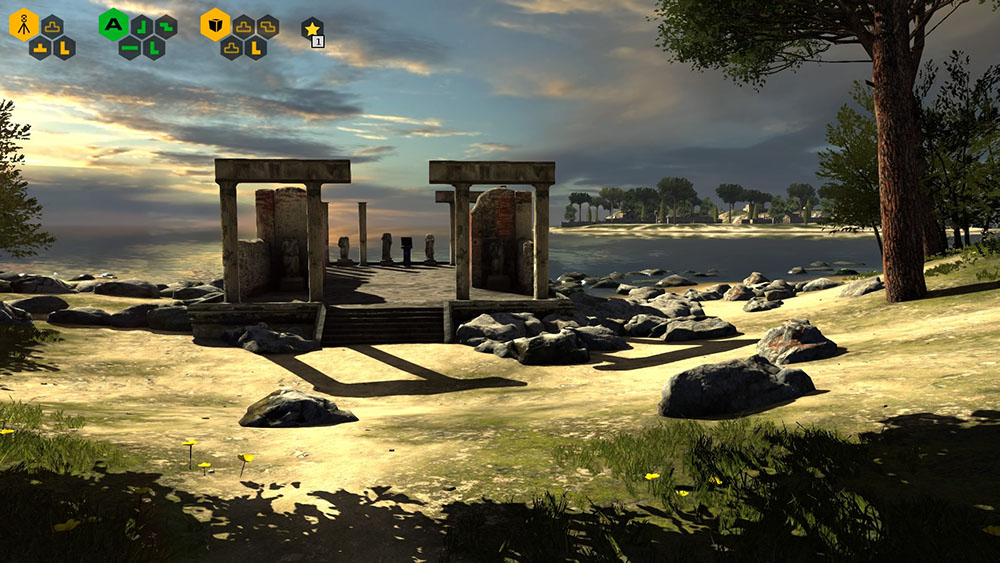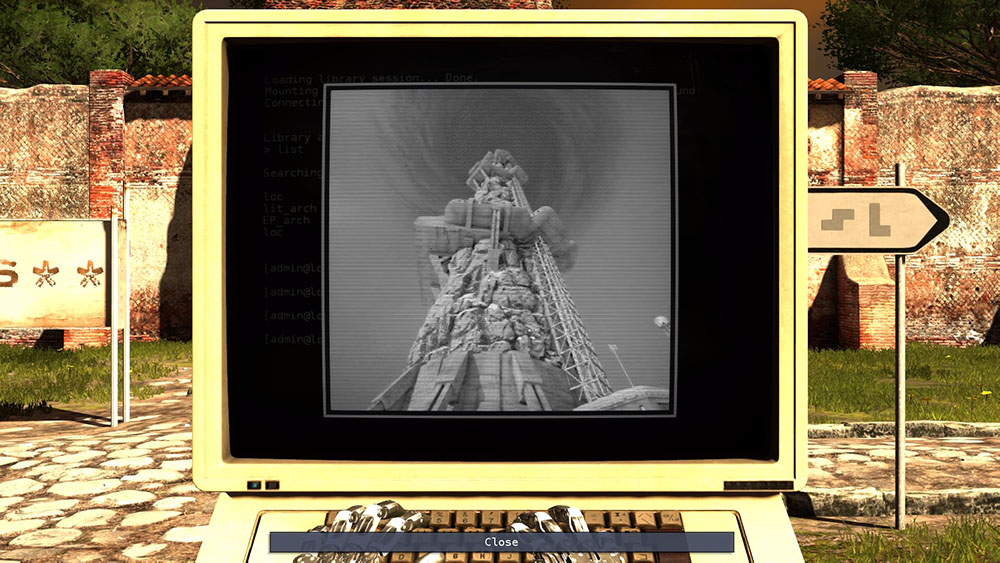Let's have a look at The Talos Principle, a puzzle game from 2014, which was the year of Jennifer Lawrence surrounded by flames. That's how I remember 2014. And 2015. They were the years of Jennifer Lawrence surrounded by flames, because London was covered with posters for The Hunger Games: Mockingjay and its sequel, The Hunger Games: Mockingjay. I miss those posters. It was only a few years ago but I feel nostalgic for those posters.
It was all different back then. Jennifer Lawrence was a thing. Electric cars were mostly crap. Snakes did not have breasts because XCOM 2 hadn't come out yet, and the thought of humanity being brought to its knees by a global pandemic was fanciful - unless you had played The Talos Principle, but I'll get to that. The game recently went on sale so I decided to check
it out.
Is it any good? Yes. It deserved all the award nominations it got. It didn't win anything because it was too left-field, but it deserved those nominations. Talos was made by Croteam, a Croatian development team famous for
the Serious Sam games, in which you blow up huge waves of baddies
in a series of visually attractive but mostly empty giant arenas. The
Sam games are cheerfully brainless -
Duke Nukem crossed with Smash TV - but The Talos Principle is a complete change of tack. It's a meditative puzzle game with a philosophical bent.
Chip's Challenge in 3D, with a story.
Purely as a puzzle game Talos is clever albeit occasionally
frustrating, but it also works as a story with an emotional core, which is
impressive given that the gameplay mostly consists of putting boxes on
pressure plates and looking through holes.
It takes place in the future. Decades,
centuries, possibly longer. We're all dead. A thaw in the arctic
permafrost unleashed an ancient virus that was lethal to primates, including
us. It was a slow-acting sleeping sickness with a lengthy gestation period, so
by the time the world's virologists woke up to the threat the virus was too
widespread to be contained.
There's an implication that the virus can survive indefinitely in the
natural environment, which means that the Earth is now permanently
inhospitable to primate life. Other animals are apparently okay, but the human
race is dead and gone, not to return on this day or any other day.
The orangutans are dead as well. What of the lemur? Probably dead. Most
of the historical record has been erased by the passage of time.
Sounds bleak, doesn't it? And yet the game is surprisingly hopeful. It turns
out that a group of human scientists came up with a plan to ensure that
something of humanity would survive. They proposed to create an artificial
intelligence that would inherit the Earth from us.
They didn't have the computing power to generate an artificial soul at the
time, so they hoped that by letting successive generations of AI agents loose on a series of
logical puzzle games a thinking creature would
emerge. The ultimate goal was to create an AI that could think for itself, at
which point it was ready to be uploaded into a physical robot body and released to
the wild.
However there is trouble in paradise. The mainframe in which the simulation is hosted is slowly failing, and in an unexpected twist the host program that runs the simulation has also become intelligent, and isn't keen on ending it all.
It's an unusually elaborate set-up for a puzzle game, but as with
The Witness the developers decided to use the puzzles to make a
series of philosophical points about perception, the nature of life, free will
etc. The game also poses a bunch of questions. Is this robot
thing us? Is humanity just a collection of DNA, or something else?
Given that the human body is a mass of cells acting in concert,
are we even us? If we can't live forever, can we at least project something of ourselves into the future?
In the hands of lesser developers
Talos could have been a pretentious, humourless bore. The backstory could have come across as a ridiculously OTT attempt to make the act of
putting boxes on top of pressure plates seem meaningful, but the voice acting
and writing sells it, and the story is helped along by some goofy humour. That's one thing that separates it from The Witness. It has humour.
There are only a couple of speaking parts - the seemingly-benign supreme being
Elohim, and the deceased human scientist Alexandra Drennan - but in both cases
I felt that the voice acting sold the roles. Drennan in particular had some of
the wonders-of-the-cosmos about her without being sappy.
You get a trophy for listening to all of her time capsules, and I felt sad
when the trophy notification popped up, because it meant she was gone. The first and
only time I have felt sad at getting a PlayStation trophy.
Incidentally I played The Talos Principle on the PlayStation 4.
The performance is unusually choppy, which is odd given that the environments
are very simple, but then again it was released in the first year of the
console's life, so perhaps Croteam were still learning the ropes.
You can mostly ignore the story, in which case it's still fun to play. The difficulty level is
finely-judged. I'll explain the gameplay. You're a robot:
You can pick things up and jump, but it's not a platform game. You use objects
to surmount the puzzles rather than clever jumping, although there are a
couple of puzzles that require you to dodge around explosive mines. These tend
to be the most nerve-wracking bits of the game, because for the most part
Talos is an ambient experience. You can foul up an arena, but
there are no penalties for resetting it. The soundtrack is lovely. The maps
are low-detail but the lighting is nice.
And then suddenly you mess up and beep-beep-beep-BOOM! a mine leaps at you and
kills you. It only happens a couple of times but it's disconcerting.
Talos is one of those games that gives you a palette of devices
and complications and then explores the way they can interact. Early on you
learn to use jammers to disable mines:
Later on you put boxes on top of pressure plates in order to open
doors, but you learn that you can put jammers on the plates instead, thus
allowing you to use a jammer to open two doors at once - the first door
with the plate and the second door by jamming it. A lot of the puzzles revolve
around efficiency. I often found myself solving most of a level only to run
out of tools before the final door, so I had to go back and work out how to
make my solution more efficient.
Some doors require that you channel beams with a connector from a power source
to a plug:
In that puzzle I've had to put the connector on a box, because otherwise
the two beams would intersect. Later on there are fans that can be used to
lift boxes up into the air, thus giving the connector a bigger field of view:
And in the shot above I've put a connector on top of a wall. This illustrates the
game's major strength, which is that I often solved puzzles in a way that
looked wrong, but the game kept going. As long as the solution works the game
will let you carry on. I can't tell if it's the result of extensive playtesting or just plain luck, but... well, luck is a skill, isn't it? Napoleon used to ask his generals if they were lucky. Admittedly he lost, and then lost again, but the point still stands.
The most unusual mechanism is the recorder, which records your actions and
plays them back with a translucent robot double:
The clone creates insubstantial-but-functional copies of world objects, and in
general the puzzles that involve the clone are the hardest in the game. You have to project your mind through time and space in order to solve them. Towards the end Talos gives you a portable
platform as well, but that element feels underutilised.
The Witness (2016)
Talos is often compared with The Witness, which was in development at the same time but didn't come out for another two years. The Witness has nicer lighting, although it's static - Talos has wind - and the puzzles are often fiendishly clever, but it felt sterile and I got tired of it.
Against you, there are mines that move in preset paths but seek you out if you get
too close - you can't dodge them at that point - and broken mines that merely
get in the way. And miniguns that shoot you if you move into their field of
view.
That's about it for gameplay elements, but it's a versatile palette that
sustains three sets of seven levels plus half a dozen bonus levels and some
extra bits.
Why are you doing all this? The game is divided into a series of worlds, each
of which contains a bunch of puzzle arenas. At the end of each arena there's a
reward - a sigil, essentially a Tetris piece - and once you have enough sigils
you can unlock the next arena. There's also a giant tower, but you're not
supposed to climb it. Elohim said so. Instead he wants you to solve all the puzzles and run through a door, where you will be granted eternal life, although it's obvious that something's fishy.
As mentioned in the text you have to jump, but The Talos Principle
isn't a reaction-based platform game. As long as you can see these
footprints you'll make the jump.
There are some more mechanics. You can unlock helper robots that will give you
hints, but by the time you do it's largely pointless. Each map also has a
bunch of hidden stars, which unlock a special ending. Some of the stars are
hidden in such a way that you have to break out of the puzzles in order to get
them, e.g.:
The purple forcefields confiscate puzzle items, but they don't stop beams.
Is the gameplay any good? I have a wary relationship with puzzle games. For
all its clever design The Witness often irritated me. After
finishing a difficult puzzle I frequently felt drained and worn instead of
entertained. I didn't feel as if I had applied myself or worked something out.
Instead I felt as if I was just tracing lines back and forth on a grid for ten minutes until
they looked right.
Some of the puzzles were great - the audio puzzles in the jungle area stood
out, because I have a musical bent and finished them in no time - but there
were too many trace-the-line grids. Perhaps it's personal taste. I didn't get
along with them. Talos is occasionally frustrating as well,
because a few puzzles involve assembling sigils into a coherent whole, which
isn't a million miles from the trace-the-line gameplay of The Witness:
There are a few rules of thumb but I felt as if I was just moving blocks
around randomly. Perhaps spatial reasoning is the key thing that separates us
from lesser forms of life, but it doesn't feel clever. Furthermore if I wanted to test my spatial reasoning in an entertaining way, why not play almost any other video game ever made? R-Type, for example, or... I don't know, Wario Ware?
It's a shame because the rest of the game is finely-balanced. Often I was
baffled by a puzzle until I came back to it later on, at which point something
clicked in my mind, as if I had been processing it subconsciously. The game
even makes reference to this:
Outside the context of the sigil puzzles Talos is tough-but-fair, and at least until the
recorder came along I felt I had a handle on the puzzles, in which case
the fun came from implementing the solution rather than bashing my head
against a wall.
It reminded me a bit of Pete Cooke's
Tower of Babel, a 1990 puzzle game for the 16-bit computers that is now sadly obscure. In
that game you controlled a trio of robots that each had a special action, and
by programming them to move in concert you solved a series of 3D puzzles. I
remember reaching a point where I could solve the levels in just a couple of
tries, and from what I remember I managed to finish it.
I finished Talos as well. There came a point where the game
clicked, and I got the hang of the mechanics. The late-game introduction of a
platform did very little to make things more difficult, and I was only thrown
by the final level's time limit, and even then I enjoyed it because the last
level feels epic. I don't want to spoil things but it delivered a
satisfying, bitter-sweet emotional payoff. That's what separates
Talos from e.g. Antichamber, e.g. it's not just a
mindbending series of puzzles, it has a story.
Bad stuff? One of the optional puzzles is obtuse to the point of insanity, and
requires that you use your mobile phone to decode a QR code and then make a
mental leap. It's a one-off that appears early in the game, so perhaps the
developers decided not to go down that path again. The rest of the optional
puzzles are mostly tough but fair.
The fact that you can put boxes on top of
mines and ride them around without dying isn't obvious, although I worked it
out eventually; the fact that you can ride around on top of mines and not get shot by
guns that can clearly see you is less obvious.
The presence of miniguns as puzzle elements feels off, as if the team were
stuck with reusing assets from Serious Sam. Miniguns feel out of place
in a philosophical puzzle game, but that's a minor quibble. As mentioned the
performance on PS4 is all over the place. I'm not a frame rate snob, but
sometimes it was downright jerky.

DLC? Ignoring the novelty DLC, there's a set of block puzzles that were released as The Sigils of Elohim,
a free teaser for the game. I wasn't keen on the block puzzles so I haven't
tried it. You can carry over some of the stars you earn into the main game,
but the rewards are trivial. There was also an extensive mission pack,
Road to Gehenna, which has more puzzles and a separate storyline. The puzzles are apparently a lot
harder. I had a go at the first one but gave up after fifteen minutes. The
problem is that Talos is finely-balanced - it never gets
frustratingly hard - but pushing the difficulty up ruins that. Perhaps
Gehenna is a hidden gem. I don't know. I'll come back to it one
day.
The key thing is price. I can't tell how long I played Talos, but
£29.99 feels steep. It doesn't really have any replay value. The soundtrack is
nice but very low-key. At £15.99 however (with Gehenna) it's terrific.
I got it for £5.99, which is incredible value, albeit that if you don't have a PlayStation you need to
factor in the cost of the console on top of that.
The Talos Principle was officially released as a digital download
only, but as with
Gris there was a limited-run physical release by Special Reserve Games, but
only for the Nintendo Switch. In fact it was released only a few weeks ago,
back in June. The box had a reversible cover and a little booklet. I say
had because, inevitably, it sold out the moment it was announced.
Why Switch? Are Switch cartridges cheaper to make than Blu-Ray discs? Do
publishers have to pay a tonne of cash to Sony if they want to release
something for the PlayStation 4? Who knows. In any case that's all I have to say about The Talos Principle, goodbye.

























































